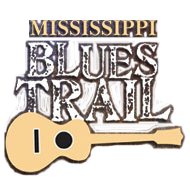Papa Lightfoot
Papa Lightfoot - Natchez
The rich legacy of blues, jazz, and gospel in Natchez has often been obscured by the tragic shadow of the notorious Rhythm Club fire that claimed some 200 lives here in 1940. Alexander “Papa George” Lightfoot was one of the most talented blues harmonica players of the post-World War II era, and in later years Jimmy Anderson, Hezekiah Early, Elmo Williams, and brothers Theodis and Y. Z. Ealey brought their Bluff City blues to audiences across the country and overseas.
African American music in Natchez has spanned an extraordinarily wide spectrum, encompassing fife and drum groups, string bands, dance orchestras, jazz, rhythm & blues, down-home blues, hip hop, gospel, and more. Among the performers active in the pre-World War II years were fiddler Butch Cage, female guitarist Geeshie Wiley, Bud Scott and his Syncopators, and several who continued to perform locally after the war, including pianist Tom Griffin, guitarist William “Cat-Iron” Carradine, and bandleading saxophonists Earl Reed and Otis Smith. The most famous and most memorialized event in Natchez musical history was the devastating fire at the Rhythm Club on April 23, 1940. Chicago bandleader Walter Barnes and most of his orchestra perished along with almost two hundred Natchez residents, including Brumfield High School music instructor Woodrich McGuire and three student bandmembers. When Library of Congress folklorists John A. Lomax and his wife Ruby stopped in Natchez in October of 1940 on a field recording expedition, Ruby Lomax wrote, “Any songs besides spirituals are hard to get here; for that terrible dance hall fire of several months ago has sent the Negro population to the mourners’ bench, and they will not sing ‘reels’ or ‘worl’ly’ songs.” However, the Lomaxes did succeed in recording Natchez blues guitarists Lucius Curtis, Willie Ford, and George Baldwin, as well as spiritual singer Alice “Judge” Richardson.
As music resumed in the clubs and cafes of Franklin, Pine, and St. Catherine streets, new talents emerged in the 1940s and ‘50s. “Papa George” Lightfoot became the best known Natchez blues artist of the era after he appeared on national radio broadcasts and recorded for several prominent record labels. Lightfoot (1924-1971) made some of his first recordings for the Sultan label, a company formed by an interracial Natchez partnership in 1950. One of its partners, Jack Davis, also recorded with his Blues Blasters band, which included James Rowan on trumpet and Joe Frazier on drums. Papa Lightfoot’s mastery of the harmonica is still heralded today, but he was unable to sustain a musical career and was remembered by many in Natchez as an ice cream peddler.
Jimmy Anderson, another noted harmonica player from Natchez, also achieved some renown as a blues recording artist in Louisiana in the 1960s. He later worked in Natchez as a radio announcer, broadcasting under the moniker “Soul Man Lee.” The fertile Natchez blues tradition has also been enriched by “Stormy Herman” Colbert, Eugene Butler and the Rocking Royals, Y. Z. Ealey and the Merrymakers, Hezekiah Early and the Houserockers, Elmo Williams, Theodis Ealey, and others.
content © Mississippi Blues Commission
[ BACK TO TOP ]

